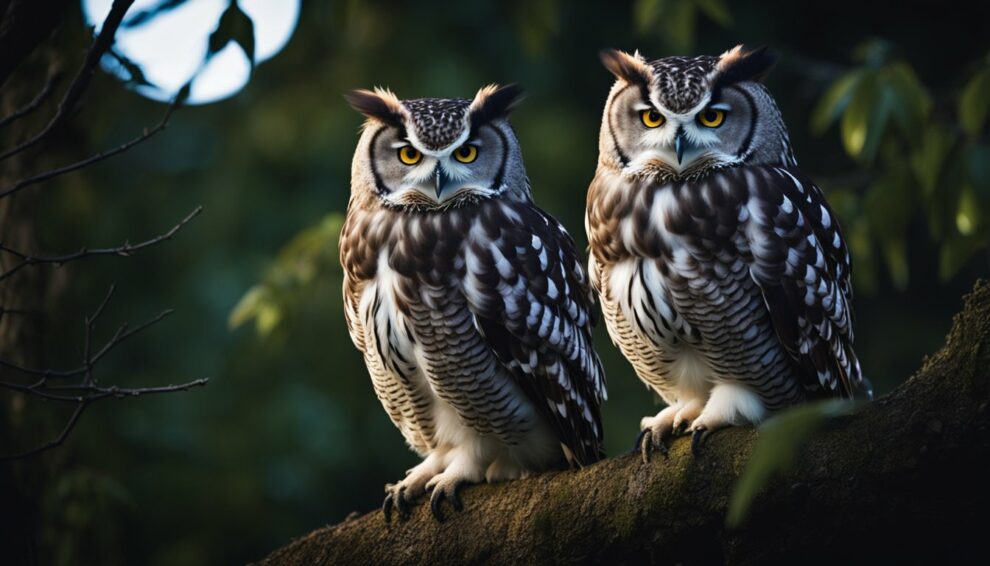Owls have long been associated with mysterious and enigmatic qualities, and their night vision is no exception.
These nocturnal birds of prey are known for their exceptional ability to see in the dark and hunt with great precision.
But what makes their eyes so unique, and how do they navigate through the darkness with such ease?

The answer lies in the structure of their eyes, which are specially adapted to low-light conditions.
Owls have large eyes that are fixed in their sockets, which means they cannot move their eyes like humans can.
Instead, they have to turn their heads to see different objects.
Their eyes are also incredibly sensitive to light, with a high concentration of light-sensitive cells called rods.
This allows them to detect even the slightest amount of light, making them highly effective at seeing in the dark.
But there’s more to their night vision than just sensitivity to light.
Owls also have a unique arrangement of cells in their eyes called foveae, which are responsible for sharp, detailed vision.
These foveae are positioned at an angle, allowing the owl to see two different images at once.
This gives them excellent depth perception and the ability to judge distances accurately, even in low-light conditions.
With these adaptations, owls are truly masters of the night, able to navigate and hunt with unparalleled precision.
Owls’ Night Vision Explained
Owls are known for their exceptional night vision, which allows them to hunt and navigate in low-light conditions.
Their eyes are well adapted to their nocturnal lifestyle, with several unique features that give them an edge over other creatures of the night.
Anatomy of Owl Eyes
Owls have large, forward-facing eyes that are fixed in their sockets.
This means that they cannot move their eyes around like humans or other animals can.
However, they have evolved a compensatory mechanism that allows them to rotate their heads up to 270 degrees, giving them a wide field of view without having to move their bodies.
The eyes themselves are also notable for their size and shape.
They are much larger than the eyes of other birds of similar size, and are almost perfectly spherical.
This gives them a larger surface area for light to enter, allowing them to gather more information about their surroundings.
Photoreceptor Cells in Owls
The key to an owl’s night vision lies in its photoreceptor cells, which are specialized cells in the retina that detect light and send signals to the brain.
Owls have two types of photoreceptor cells: rods and cones.
Rods are responsible for detecting low levels of light, and are highly sensitive to motion.
They are also more densely packed in the retina than cones, which means that owls have a higher resolution for detecting movement in low-light conditions.
Cones, on the other hand, are responsible for detecting color and fine detail.
They are less sensitive to light than rods, but are better at detecting small differences in color and brightness.
Owls have fewer cones than rods, which means that their color vision is not as good as that of diurnal birds.
Overall, the combination of large, forward-facing eyes and specialized photoreceptor cells makes owls highly adapted to their nocturnal lifestyle.
They are able to see in low-light conditions that would be impossible for most other animals, giving them a distinct advantage in the dark of night.
Adaptations for Nocturnal Hunting

Owls are highly skilled nocturnal predators that have evolved a range of adaptations to help them hunt in the dark.
These adaptations include silent flight, exceptional hearing, and sensory integration.
Silent Flight
One of the most remarkable adaptations of owls is their ability to fly silently.
This is achieved through a combination of specialized feathers and a unique wing structure.
The leading edge of an owl’s wing is serrated, which helps to break up the air as it passes over the wing, reducing turbulence and noise.
Additionally, the feathers on an owl’s wings are fringed, which further reduces turbulence and noise by muffling the sound of air passing over the feathers.
This allows owls to fly almost silently, allowing them to approach prey undetected.
Hearing and Sensory Integration
Owls also have incredible hearing, which is essential for hunting in the dark.
Their ears are located on the sides of their head, which allows them to pinpoint the location of sounds with incredible accuracy.
In fact, some species of owl can detect the movement of prey from over 60 feet away in complete darkness.
This ability is due to their unique ear structure, which allows them to detect subtle differences in sound intensity and timing between their two ears.
In addition to their exceptional hearing, owls also have remarkable sensory integration.
This means that they are able to process information from multiple sensory inputs, such as sight, sound, and touch, simultaneously.
This allows them to create a highly detailed picture of their environment, even in complete darkness.
For example, owls are able to use their beak and talons to sense the texture and shape of their prey, which helps them to locate and capture it more easily.
Overall, the adaptations of owls for nocturnal hunting are truly remarkable.
Their ability to fly silently and detect prey with incredible accuracy in complete darkness is a testament to the power of evolution and the wonders of the natural world.
Comparative Study of Owl Vision

Owls Versus Other Birds
Owls are known for their exceptional night vision, but how does it compare to other birds? The answer lies in their eyes.
Owls have large eyes that are tubular in shape, allowing more light to enter and giving them better vision in low light conditions.
In fact, the size of an owl’s eyes is proportionally larger than most other birds.
Additionally, owls have a higher density of rod cells in their retina, which are responsible for detecting light and motion.
This means that owls can see objects in low light conditions that other birds cannot.
For example, a barn owl can detect a mouse moving in a field from over 100 feet away in complete darkness.
Owls Versus Humans
Compared to humans, owls have much better night vision. Humans have only one type of rod cell in their retina, while owls have two.
This allows them to see a wider range of light wavelengths, including ultraviolet light.
Moreover, the arrangement of cells in an owl’s retina is optimized for night vision.
The fovea, which is responsible for sharp, detailed vision, is located off-center in an owl’s eye.
This allows them to see better in low light conditions by increasing the amount of light that falls on the retina.
In summary, owls have superior night vision compared to both other birds and humans.
Their large, tubular eyes and high density of rod cells in their retina allow them to see in low light conditions that other animals cannot.
Frequently Asked Questions

How do owls see in the dark when we need a flashlight?
Owls have a unique ability to see in the dark, which allows them to hunt and navigate at night.
Unlike humans, who rely on their eyes to see, owls have specialized adaptations that enable them to see in low light conditions.
They have large eyes that are capable of gathering more light than human eyes, and they also have a higher concentration of light-sensitive cells in their retinas.
Additionally, their pupils can dilate to let in more light, and they have a reflective layer at the back of their eyes called the tapetum lucidum, which helps to amplify the light that enters their eyes.
What special adaptations do owls have for night hunting?
Owls have several special adaptations that make them highly effective night hunters.
In addition to their excellent night vision, they also have incredibly sharp hearing.
Their ears are positioned on the sides of their head, and they are asymmetrical, with one ear slightly higher than the other.
This allows them to pinpoint the location of their prey by detecting slight differences in sound intensity and timing.
Owls also have soft feathers that allow them to fly silently, making it easier for them to sneak up on their prey without being detected.
Can owls see colors at night, or is their world black and white?
Owls see the world differently than humans do, but they are not completely colorblind.
While they do not see colors as vividly as we do, they can still distinguish between different hues.
However, their color vision is not as important to them as their ability to see in low light conditions.
How does the owl’s vision compare to that of other nocturnal animals?
Owls have some of the best night vision in the animal kingdom, but they are not the only animals that can see in the dark.
Other nocturnal animals, such as cats and some species of primates, also have adaptations that allow them to see in low light conditions.
However, owls have some of the largest eyes relative to their body size, which gives them an advantage when it comes to seeing in the dark.
What role do an owl’s eyes play in its ability to fly silently?
An owl’s eyes play a critical role in its ability to fly silently.
When an owl is hunting, it needs to be able to see its prey clearly while also flying quietly so as not to alert its prey.
The soft feathers around an owl’s eyes help to muffle the sound of the air passing over its wings, which allows it to fly silently.
Additionally, an owl’s eyes are positioned at the front of its head, which gives it better depth perception and allows it to judge distances more accurately.
Are there any differences in night vision between owl species?
Different owl species have slightly different adaptations that allow them to see in the dark.
For example, some species have larger eyes than others, while others have more light-sensitive cells in their retinas.
However, all owl species have excellent night vision, which is critical for their survival.









